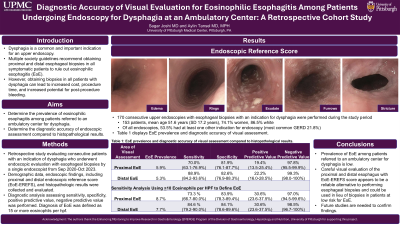Monday Poster Session
Category: Esophagus
P2197 - Diagnostic Accuracy of Visual Evaluation for Eosinophilic Esophagitis Among Patients Undergoing Endoscopy for Dysphagia at an Ambulatory Center: A Retrospective Cohort Study
Monday, October 28, 2024
10:30 AM - 4:00 PM ET
Location: Exhibit Hall E

Has Audio
- SJ
Sagar Joshi, MD
University of Pittsburgh Medical Center
Pittsburgh, PA
Presenting Author(s)
Sagar Joshi, MD, Aylin Tansel, MD, MPH
University of Pittsburgh Medical Center, Pittsburgh, PA
Introduction: Dysphagia is a common and important indication for an upper endoscopy. Multiple society guidelines recommend obtaining proximal and distal esophageal biopsies in all symptomatic patients to rule out eosinophilic esophagitis (EoE). However, obtaining biopsies in all patients with dysphagia can lead to increased cost, procedure time, and increased potential for post-procedure bleeding. We aimed to determine the diagnostic accuracy of endoscopic assessment compared to histopathological results.
Methods: We conducted a retrospective study evaluating consecutive patients with an indication of dysphagia who underwent endoscopic evaluation with esophageal biopsies by a single endoscopist from Sep 2020 through Oct 2023. Demographic data, endoscopic findings, including proximal and distal endoscopic reference score (EoE-EREFS), and histopathologic results were collected and evaluated. Diagnostic analysis assessing sensitivity, specificity, positive predictive value, negative predictive value was performed. Diagnosis of EoE was defined as 15 or more eosinophils per hpf.
Results: A total of 170 consecutive upper endoscopies with esophageal biopsies with an indication for dysphagia were performed during the study period (153 patients, mean age 51.5 years, 74.1% women, 86.5% white, 21.1% EoE-EREFS >2). The diagnostic accuracy of visual assessment for proximal EoE was: prevalence 5.9%, sensitivity 70.0% (63.1-76.9%), specificity 81.9% (76.1-87.7%), positive predictive value 19.4% (13.5-25.4%), negative predictive value 97.8% (95.5-99.9%).The diagnostic accuracy of visual assessment for distal EoE was: prevalence 5.3%, sensitivity 88.9% (84.2-93.6%), specificity 82.6% (76.9-88.3%), positive predictive value 22.2% (16.0-28.5%), negative predictive value 99.3% (98.0-100%). Sensitivity analysis using 10 or more eosinophils per hpf showed diagnostic accuracy for proximal esophagus (prevalence 8.7%, sensitivity 73.3 %, specificity 83.9%, PPV 30.6%, NPV 97.0%) and for distal esophagus (prevalence 7.7%, sensitivity 84.6 %, specificity 84.1%, PPV 30.6%, NPV 98.5%), respectively.
Discussion: The prevalence of EoE among patients referred to an ambulatory center is low. Additionally, careful visual evaluation of the proximal and distal esophagus with EoE-EREFS score appears to be a reliable alternative to performing esophageal biopsies. Future studies are needed to confirm findings.
Note: The table for this abstract can be viewed in the ePoster Gallery section of the ACG 2024 ePoster Site or in The American Journal of Gastroenterology's abstract supplement issue, both of which will be available starting October 27, 2024.
Disclosures:
Sagar Joshi, MD, Aylin Tansel, MD, MPH. P2197 - Diagnostic Accuracy of Visual Evaluation for Eosinophilic Esophagitis Among Patients Undergoing Endoscopy for Dysphagia at an Ambulatory Center: A Retrospective Cohort Study, ACG 2024 Annual Scientific Meeting Abstracts. Philadelphia, PA: American College of Gastroenterology.
University of Pittsburgh Medical Center, Pittsburgh, PA
Introduction: Dysphagia is a common and important indication for an upper endoscopy. Multiple society guidelines recommend obtaining proximal and distal esophageal biopsies in all symptomatic patients to rule out eosinophilic esophagitis (EoE). However, obtaining biopsies in all patients with dysphagia can lead to increased cost, procedure time, and increased potential for post-procedure bleeding. We aimed to determine the diagnostic accuracy of endoscopic assessment compared to histopathological results.
Methods: We conducted a retrospective study evaluating consecutive patients with an indication of dysphagia who underwent endoscopic evaluation with esophageal biopsies by a single endoscopist from Sep 2020 through Oct 2023. Demographic data, endoscopic findings, including proximal and distal endoscopic reference score (EoE-EREFS), and histopathologic results were collected and evaluated. Diagnostic analysis assessing sensitivity, specificity, positive predictive value, negative predictive value was performed. Diagnosis of EoE was defined as 15 or more eosinophils per hpf.
Results: A total of 170 consecutive upper endoscopies with esophageal biopsies with an indication for dysphagia were performed during the study period (153 patients, mean age 51.5 years, 74.1% women, 86.5% white, 21.1% EoE-EREFS >2). The diagnostic accuracy of visual assessment for proximal EoE was: prevalence 5.9%, sensitivity 70.0% (63.1-76.9%), specificity 81.9% (76.1-87.7%), positive predictive value 19.4% (13.5-25.4%), negative predictive value 97.8% (95.5-99.9%).The diagnostic accuracy of visual assessment for distal EoE was: prevalence 5.3%, sensitivity 88.9% (84.2-93.6%), specificity 82.6% (76.9-88.3%), positive predictive value 22.2% (16.0-28.5%), negative predictive value 99.3% (98.0-100%). Sensitivity analysis using 10 or more eosinophils per hpf showed diagnostic accuracy for proximal esophagus (prevalence 8.7%, sensitivity 73.3 %, specificity 83.9%, PPV 30.6%, NPV 97.0%) and for distal esophagus (prevalence 7.7%, sensitivity 84.6 %, specificity 84.1%, PPV 30.6%, NPV 98.5%), respectively.
Discussion: The prevalence of EoE among patients referred to an ambulatory center is low. Additionally, careful visual evaluation of the proximal and distal esophagus with EoE-EREFS score appears to be a reliable alternative to performing esophageal biopsies. Future studies are needed to confirm findings.
Note: The table for this abstract can be viewed in the ePoster Gallery section of the ACG 2024 ePoster Site or in The American Journal of Gastroenterology's abstract supplement issue, both of which will be available starting October 27, 2024.
Disclosures:
Sagar Joshi indicated no relevant financial relationships.
Aylin Tansel indicated no relevant financial relationships.
Sagar Joshi, MD, Aylin Tansel, MD, MPH. P2197 - Diagnostic Accuracy of Visual Evaluation for Eosinophilic Esophagitis Among Patients Undergoing Endoscopy for Dysphagia at an Ambulatory Center: A Retrospective Cohort Study, ACG 2024 Annual Scientific Meeting Abstracts. Philadelphia, PA: American College of Gastroenterology.
